AMD AM1 Platform Announced: Socketed Kabini
by Ian Cutress on March 4, 2014 8:01 AM EST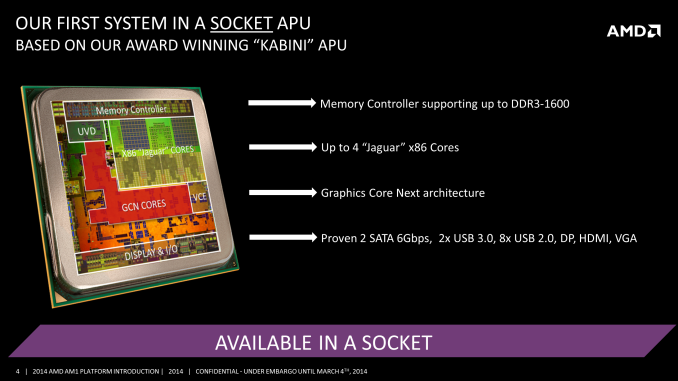
From the Consumer Electronics Show at the turn of the year, images were coming out of motherboards supporting the FS1b socket. This socket was a pin-grid-array, rather than a soldered on package which we had seen at Computex 2013. Then a couple of weeks later, we reported on a leak regarding several PGA system-on-chips with the Kabini name destined for the FS1b socket. Today AMD is formalizing that announcement into the AM1 platform – A Kabini APU combined with a socketed FS1b motherboard.
We have examined Kabini in the laptop and mobile space; however AMD sees a market particularly in regions with low GDP. Users of these markets have asked for low cost systems that remain upgradable. With the AM1 platform, AMD is aiming for a combined SoC and motherboard in the $60 region, remaining socketed for an upgrade path.
The Kabini processors will be similar to their laptop counterparts – up to four Jaguar based CPU cores, a single memory controller supporting up to 1600 MHz memory and 128 streaming processors from the Graphics Core Next architecture. Due to the SoC element of the CPU, there is no chipset on the motherboard and all the IO will be present on the CPU itself. This should help drive the cost of the motherboards down such that another IC does not need to be engineered in. The Kabini APUs will source two SATA 6 Gbps ports, two USB 3.0 ports, eight USB 2.0 ports, four PCIe 2.0 lanes and a trio of video outputs (DisplayPort, HDMI, and VGA).
At launch, on April 9th, AMD have 15 motherboards planned from the major motherboard manufacturers. They will mostly be in the micro-ATX form factor, with a couple in the mini-ITX size. We reported on several motherboards from Computex and CES, such as this from MSI:
With the use of four PCIe 2.0 lanes, AMD is not expecting these systems to be used with anything other than a low end discrete graphics card (R5 230 or GT210) for more screens. The bandwidth would be limiting, and as a result anything other than low-resolution/low-quality gaming would be possible. Also, no dual graphics co-operation is currently planned from AMD.
The list of APUs coming to release, as far as we can tell, still comes from the leak via Chinese VR-Zone. Compared alongside some of the socketed Kabini:
| AMD AM1 Kabini | AMD FT3 Kabini | |||||
| A6-5350 | A4-5150 | E2-3850 | E1-2650 | A6-5200 | E1-2500 | |
| Cores / Threads | 4 / 4 | 4 / 4 | 4 / 4 | 2 / 2 | 4 / 4 | 2 / 2 |
| CPU Frequency | 2050 | 1600 | 1300 | 1450 | 2000 | 1400 |
| GPU | HD 8400 | HD 8400 | HD 8280 | HD 8240 | HD 8400 | HD 8240 |
| GPU SPs | 128 | 128 | 128 | 128 | 128 | 128 |
| GPU Frequency | 600 | 600 | 450 | 400 | 600 | 400 |
| L2 Cache | 2MB | 2MB | 2MB | 1MB | 2MB | 2MB |
| TDP | 25 W | 25 W | 25 W | 25 W | 25 W | 25 W |
At this time, AMD have not confirmed these SKUs. But we were able to confirm that AMD is aiming at the Kabini APU line to be 128 SPs and 25W. There are no plans to release lower wattage parts. The reasoning behind this is for desktop systems are often not restricted on power, and thus the difference between a 15W APU and a 25W APU is ultimately not that much at the end of the day, and the lower TDP part will sacrifice performance.
The big competition for AMD in this segment is desktop Bay Trail. AMD is keen to point out the differences between the two:
So all Kabini APUs will support Windows XP onwards, and all accept both 32-bit and 64-bit operating systems. Maximum memory support is 16GB at DDR3-1600 MHz. A couple of points AMD fail to mention on this slide are relatively important:
- Kabini APUs are all single channel memory, compared to BayTrail / Silvermont CPUs that are dual channel.
- Kabini APUs are 25W, whereas Silvermont CPUs are 10-15W on average.
- Finding a non 64-bit BayTrail system is hard – I only found reference to BayTrail-T CPUs that might be 32-bit only, and these systems are not directly competing with Kabini APUs and the AM1 platform.
Further questioning to Adam Kozak has suggested that the AM1 systems should support memory overclocking above the verified DDR3-1600 MHz speed. Unfortunately these APUs will not have any Turbo Core technology however, nor will they support CPU overclocking.
I also probed further on a couple of topics:
Beema Desktop APUs replacing Kabini Desktop: Currently AMD is still discussing whether Beema will be released in a similar vein to AM1, preferably in the same socket despite the presence of the Platform Security Processor. There needs to be some longevity in the platform, but the focus on Beema to begin with will be in the laptop and mobile markets.
Robustness of AM1 over future updates: AMD hope to keep the FS1b socket for the AM1 platform going forward.
Scope for an 8-core Jaguar Kabini APU, or a 2-core and larger IGP: AMD will focus purely on the quad-core APU with 128 SP GCN graphics at this time.
Having briefly tested Jaguar in a desktop platform in-house, AMD is clearly making a low-end play where volumes can be high while profit-margins are low. Even if the motherboard and APU combined are $60, the rest of the system can easily double that, minus a monitor and an OS, which could bring the total up nearer $200 or $250. At this price point, the main competition is Windows (or Linux) enabled tablets, or depending on the workload, even Android enabled tablets. There is scope for other markets (as a cheaper compute machine) in there too. The single channel memory situation is a little odd when it comes to throughput, reducing peak bandwidth to 12.8 GB/s. The upgradable element for this market means that should faster processors come along, they would be upgradeable, however the jump to a Bulldozer-based architecture could be had for as little as $88 (AMD A4-4000 and GIGABYTE F2A55M-DS2) with more IO to play with.
Release date for Kabini APUs and motherboards: Formally the AM1 products are to be available in early April, with global availability expected on April 9th. Pricing and APU SKU lists have not been announced, so it is unclear if that $60 target for motherboard plus APU is on the low end or the high end. We have asked regarding samples for the platform and look forward to testing.


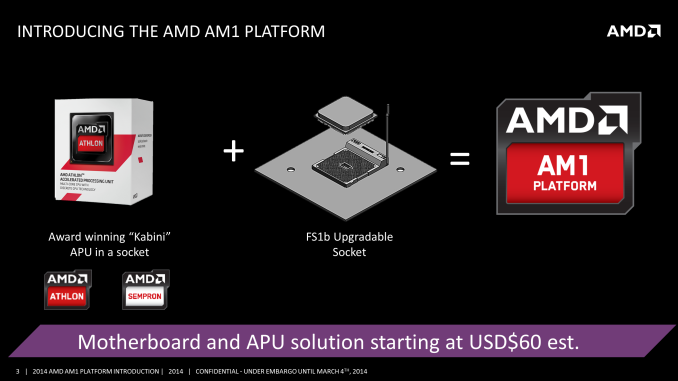
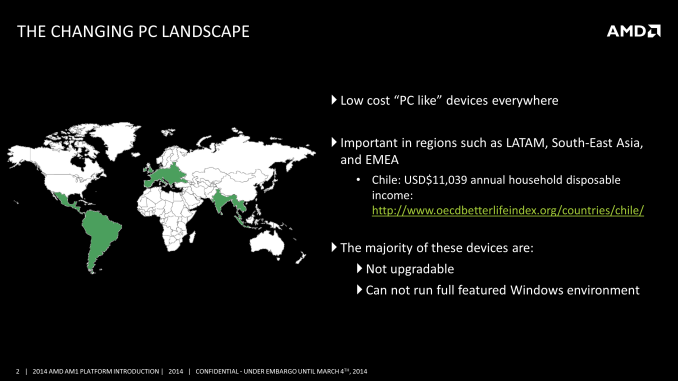
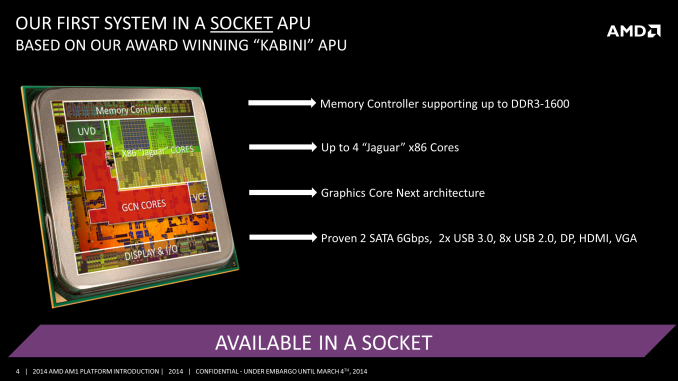
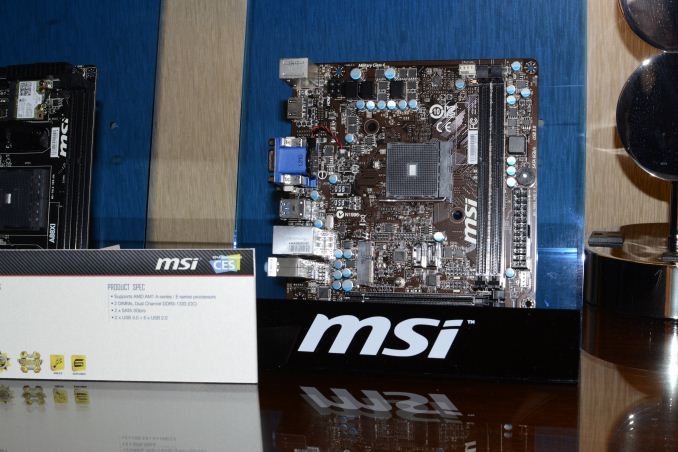

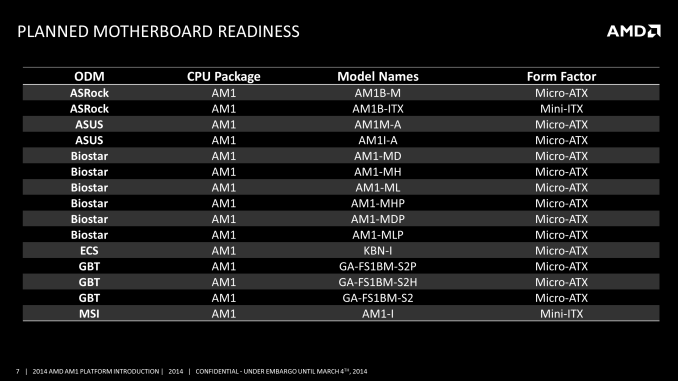








38 Comments
View All Comments
fancylearar - Tuesday, March 4, 2014 - link
This looks interesting since AMD Kabini series never truly available in desktop market but its power efficiency is amazingly good.keristerzt - Tuesday, March 4, 2014 - link
It's true if only compared to it's predecessor, but compare to it's competitor max TDP is not even close. I'm in SE-Asia and most of us don't use AMD APU that much, except for Laptop, for desktop part we mostly used Intel Processor and despite that fact that we people don't worry much about TDP, all we care is how its perform in actual day-work.mr_tawan - Tuesday, March 4, 2014 - link
I'm also in SE-Asia. AMD APU plays significant role in internet cafe in Thailand (except those hi-end cafe' that utilize top of the line CPU+GPU combination). It's cost-effective while still adequate running 3D games at reasonable framerate.R3MF - Tuesday, March 4, 2014 - link
true, i use an A4-5000 kabini SFF system as a home server, and it is doing a stellar job considering the £150 price tag for an OS'less computer.saiki4116 - Friday, March 7, 2014 - link
I was planning to do a build with A4-4000 for my parents as they don't need that much processing power.I am OK with the I/O selection, except for Single Channel memory. I should see this processors multimedia capabilities.drezden444 - Wednesday, April 9, 2014 - link
a6 5200 is even better. I was surprised by it's calculation capabilities in 25W form. I even wonder what will happen if we rise the freq. to 45Wlurker22 - Tuesday, March 4, 2014 - link
Ok I am confused (why does AMD make their product map such a confusing mess). Are these the sockets which will be used with the FX-6300,8300 etc CPU line?Homeles - Tuesday, March 4, 2014 - link
No. Those are AM3+. This should be an SoC only socket.If AMD does end up launching a new line of FX processors, which likely wouldn't be until Excavator, they'd probably be on FM2+.
lurker22 - Tuesday, March 4, 2014 - link
Thank you very much for the clarification. So it would be better to wait for the FM2+ as the AM3+ is a dead end now?Flunk - Tuesday, March 4, 2014 - link
I think more realistically the GPU-less processors are dead. If AMD releases a new FX-series part it will likely be based on an APU part either with less space allocated to the GPU or the GPU disabled.